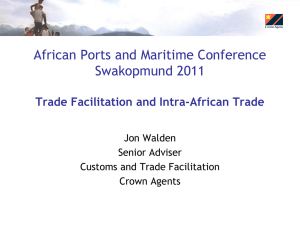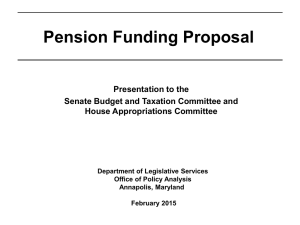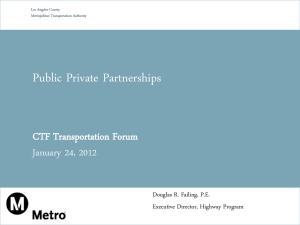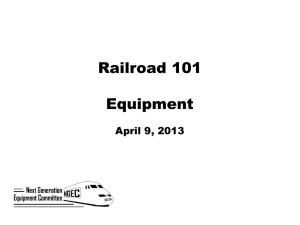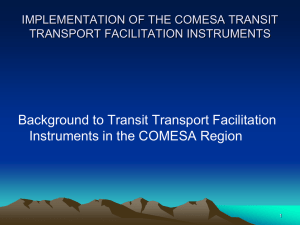What are Trade Costs? - Lutte anti
advertisement
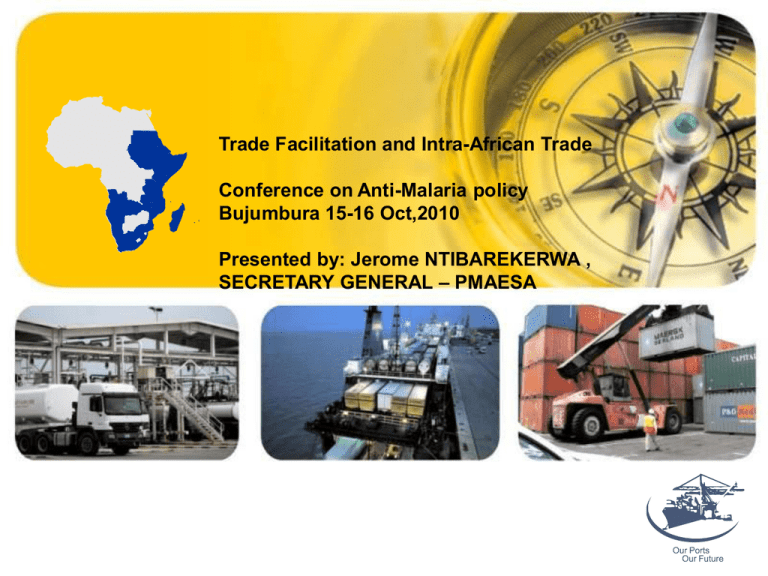
Trade Facilitation and Intra-African Trade Conference on Anti-Malaria policy Bujumbura 15-16 Oct,2010 Presented by: Jerome NTIBAREKERWA , SECRETARY GENERAL – PMAESA Outline of Presentation Introduction of PMAESA The facilitation of Trade in Africa. Regional Initiatives to tackling the challenges of Trade Facilitation in Africa. Overview of Transit Corridors in the region Concluding Remarks. Introduction Who we are Port Management Association of Eastern & Southern Africa (PMAESA) is a regional grouping of ports in the eastern and southern Africa with membership composed of state representatives from: • Port Authorities • Maritime transport departments • Port Operators • Maritime regulators Introduction Established under the auspices of the UNECA with the following objectives among others: • Offer platform to exchange ideas and information where members can interface with one another in transport and trade facilitation • Assist development organs by modernization to enhance productivity and service delivery and trade facilitation • Establish and maintain relations with other development partners and transport authorities for the study of matters beneficial to members FOCUS of the Association Focus • Visibility – Communications • Development of Human Resources • Port development • Development of Ports Activities integrated to Transport Corridors • Respect for international norms/conventions Strategic Objectives Objective 1 Improve visibility and image of the Association, by implementation of an appropriate communication policy among the members of the Association and partners Objective 2 Contribute to the development of maritime and port expertise in the subregion Objective 3 Improving the financial resources of the Association and ensure their efficient usage Ports Corridor Partnerships PMAESA ports facilitated a volume of 270.0 million tons of cargo in 2008 up from 249.2 million tons in 2007, representing 90% of the total traffic. Nine transit corridors provide linkage and flow of traffic to and from the ports in the region: • Northern Corridor • Central Corridor; •Djibouti corridor • The Trans-Kalahari Corridor • The Maputo Corridor • The Durban Corridor The Northern Corridor only facilitated 17 million tons in 2009. The bulk of this traffic is handled by truck operators. This emphasis the significant role played by the truck drivers in the maritime sector. Introduction TRADE FACILITATION IN AFRICA REGION Despite Africa’s determination to dismantle trade restrictions in order to create a common market within the framework of regional and sub-regional agreements, barriers to intra-regional-economiccommunity trade development are numerous. These barriers are mostly the consequences of the economic structure of the countries; institutional policies, weak infrastructure; weak financial and capital markets and failure to implement trade protocols. The Links between Trade, Growth and Poverty Reduction Baldwin (2003), has demonstrated that countries with few restrictions on trade achieve faster economic growth than countries that have more restrictions on trade. This is because trade liberalization reduces distortions in relative prices, and allows those activities with a comparative advantage to expand and consequently faster economic growth. An Economic Case for Trade Facilitation What is Trade Facilitation? According to the WTO, trade facilitation refers to “the simplification and harmonization of international trade procedures” covering the “activities, practices and formalities involved in collecting, presenting, communicating and processing data required for the movement of goods in international trade.”. An Economic Case for Trade Facilitation (II) Why does Trade Facilitation Matter? The importance of trade facilitation stems from the fact that global trade has grown rapidly in recent years because of the progressive reduction of tariffs and quotas as a result of trade liberalisation. This implies that more goods are crossing borders and having to comply with Customs formalities, putting a strain on the resources of custom officials and other government officials. An Economic Case for Trade Facilitation (III) The Literature shows that: There is a positive link between trade facilitation and trade. Modest reductions in trade transaction costs significantly increase trade flows. Trade in both rich and poor countries stand to gain from improvements in trade facilitation. However, trade gains are higher in developing countries than in developed countries because of comparatively less efficient customs administrations and ports in developing countries. An Economic Case for Trade Facilitation (III) Countries that undertake trade facilitation reforms stand to gain substantially from enhanced efficiency of customs procedures. The potential gain from increasing port efficiency is considerably larger than for increasing efficiency of customs procedures. Nevertheless, improved customs procedures significantly increase trade flows. Inefficient movement of goods across borders is a serious impediment to trade and growth. What are Trade Costs? The literature defines total trade costs broadly as all costs incurred in getting a final good to a final user – other than the cost of producing the good itself. In general, exporters or importers incur trade costs at all stages of the processes involved in exporting and importing goods. The costs begin to tally with obtaining information about market conditions in a foreign market and ends with receipt of final payment for a good. Estimates of Trade Costs in Industrialized countries Estimates of Trade Costs in Industrialized countries(II) Anderson and Van Wincoop (2004) calculate that the average trade costs for industrialized countries are equivalent to an ad-valorem term of 170%. The estimated trade costs represents the total for three components: a 21% ad-valorem equivalent for transportation costs, 44% for border-related trade barriers, and 55% for retail and wholesale distribution costs Transport Cost (freight costs as a percentage of total import value) Transport Cost (freight costs as a percentage of total import value) (II) Africa in general, and SSA in particular, has the highest cost rates in the world. This is further supported by the World Bank’s (2008) Doing Business Report which suggests that the trading costs for African countries are about twice as high than as those in high-income OECD countries. Why are trade costs higher in Africa? Poor Road and Rail Transport Infrastructure. Poor Port and Maritime Transport. Poor Vehicle use and management. High Transport cost Cumbersome Customs procedures Why are trade costs higher in Africa? (II) Unwarranted road blocks. Product Standards and Technical Regulations. Information and communication costs. Poor and inadequate payment mechanism Costs associated to preferential trade: rules of origin Proportion of paved and unpaved roads in Africa Transport costs from selected cities to Rotterdam, Netherlands Number of Exports and Imports Procedures Delays in days, compared by world regional and country groupings Checkpoints on selected Eastern and Western African Highways Highways Distance (km) Number of Checkpoints Mombassa – BujumburA Dar Es Saalam LoméOuagadougou Cotonou-Niamey 1600 18 Checkp oints per 100 km 2.6 1400 1036 25 23 2.09 2.22 1036 34 3.28 AbidjanOuagadougou NiameyOuagadougou 1122 37 3.30 529 20 3.78 Internet Diffusion worldwide (users per 1,000 populations) REGIONAL INITIATIVES • Development agencies such as the World Bank (SSATP), the AfDB, the EU etc place emphasis on the facilitation of inter-State trade along corridors. • Increasingly funding corridor developments along corridors Borders delays, a proliferation of road checkpoints and other practices that increase monetary and time costs. • Various initiatives have been designed to both monitor the performance of corridors and to eliminate the nontariffs barriers (NTBs); • The objective is to enhance the efficiency and costeffectiveness of the main transport corridors into landlocked countries Regional Initiatives (cont..) • In eastern and southern Africa, Corridor Management Committees are emerging as strategic institutions for addressing all aspects of transport and transit of goods throughout a given corridor, • Some Agreementssigned by all participating countries and private sector stakeholders to deal with a wide range of issues such as infrastructure, customs, bottle-necks and user charges. • Number of corridor management institutions have been set up such as Walvis Bay Corridor Group, Maputo Development Corridor ,North-South Corridor in Southern Africa. Regional initiatives (cont…) • The Northern Corridor Transit Agreement ( NCTA, 1987) has been signed by five countries: Kenya, Uganda, Rwanda, Burundi and DRC to guarantee each other free passage through their respective territories of transit traffic and trade. • The NCTA has led to the establishment of A Northern Corridor Transit Transport Coordination Authority • The Djibouti Corridor in the Horn of Africa is a multi-modal network of routes linking the Port of Djibouti to the landlocked Ethiopia; • Corridor management Institutions (CMIs) are therefore promoting and developing various transit corridors across Africa ; • Challenge remains to set up a critical forum of consultation and coordination given the diversity of stakeholders and a large number of government agencies that oversee different activities within a corridor. Northern corridor network Northern Corridor missing link Central corridor network 4 DR CONGO 3 2 1 NB: 1- Mtwara corridor, 2- DSM TAZARA corridor, 3- DSM Central corridor, 4- Tanga corridor Maputo Corridor Concluding Remarks Improved Trade facilitation can: Significantly lower trade costs, especially reducing time; Bring about significant increases in the volume of trade, imports and exports, that may be even greater than the direct gains from trade policy reform; Concluding Remarks (II) Allow for increases collection efficiency; in government revenue and Generally contribute to welfare improvements and economic growth Concluding Remarks (III) Trade Facilitation is relevant in the context of regional integration because: Reducing the costs of trade will tend to stimulate increased trade, particularly for landlocked countries. It supports regional integration as many of the measures relate to cross-border procedures. Measures related to Customs procedures tend to increase the efficiency of revenue collection and are therefore typically associated with increases in revenue. Thank you! Merci beaucoup, Asante Sana! God bless you all !!!

